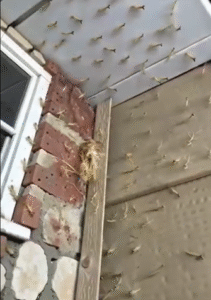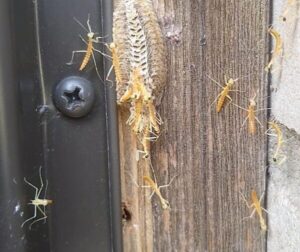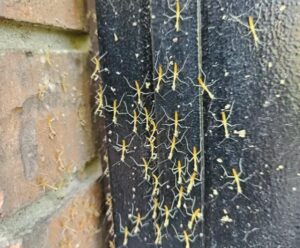A Morning Surprise: The Tiny Miracle of Praying Mantis Hatchlings

It was early morning, the kind of calm that only exists before the world fully wakes up. As I opened my front door to let in the cool air, I froze in astonishment. Scattered across the doorstep were dozens of tiny, delicate creatures — newly hatched baby praying mantises, each no bigger than my fingertip. Their miniature bodies shimmered faintly in the soft light, their fragile legs moving in perfect, cautious coordination. It felt like witnessing a secret ceremony of nature, one that unfolded quietly and beautifully right at my doorstep.
These tiny insects had just emerged from an egg case called an ootheca, a foamy, capsule-like structure their mother had carefully created months earlier. Female mantises produce these oothecae as a protective casing for their eggs, often attaching them to sturdy surfaces like branches, walls, or fence posts. Inside, the case can hold anywhere from 50 to 100 eggs, all snugly protected from winter’s cold and hungry predators. Once spring’s warmth arrives, the young mantises break free, ready to start their journey into the great unknown.

Seeing the ootheca up close is fascinating in itself — it looks almost like a small piece of hardened foam, yet within it, life develops patiently through the cold months, waiting for the perfect moment to emerge. The sight of those hatchlings exploring their surroundings felt almost symbolic — a reminder that life, in all its forms, knows exactly when to begin anew.
Praying mantises are easily recognized by their distinct “praying” stance, with their front legs folded gracefully as though in meditation. Their serene posture hides their true nature — that of a fierce and efficient predator. Despite their calm appearance, mantises are incredible hunters who help keep the ecosystem in balance. They feast on a wide range of pests including flies, mosquitoes, aphids, moths, and caterpillars, making them natural allies for gardeners and homeowners alike.
Their physical abilities are astonishing. A mantis’s head can rotate nearly 180 degrees, and its large compound eyes provide almost a full 360-degree field of vision. This means they can detect movement from virtually any direction. When prey ventures too close, the mantis strikes with lightning speed, using its spiny forelegs to trap and hold its victim in a deadly embrace. Watching one hunt is both mesmerizing and humbling — it’s nature’s precision at its finest.
As I stood there that morning, watching dozens of tiny mantises venture into the world for the first time, I felt an overwhelming sense of wonder. Some crawled up the brick wall, others disappeared into nearby flower beds and patches of grass. Their delicate bodies blended perfectly with the leaves and stems, their camouflage already serving them well. It was as if the earth itself had exhaled, releasing these small, green miracles into the morning light.

If you ever happen to spot baby mantises around your home, resist the urge to touch or move them. They are incredibly fragile at this stage and depend on their environment for safety. Avoid spraying pesticides or using chemical repellents nearby, as these substances can harm them. Instead, leave the surrounding vegetation untouched — the shrubs, grasses, and small plants will serve as shelter from birds, ants, and other predators. Over time, as they grow, they will molt several times, shedding their exoskeletons before maturing into the elegant adult mantises we recognize.
Beyond their role in pest control, praying mantises carry deep symbolic and cultural meaning around the world. In Chinese culture, they represent patience, mindfulness, and balance — virtues reflected in their calm movements and focused stillness. In African traditions, the mantis is often seen as a harbinger of good fortune and wisdom, a creature that brings messages of clarity and peace. Among Native American tribes, the mantis symbolizes awareness and inner reflection, teaching us to move through life with focus and calm intention.

Throughout history, people have observed mantises and drawn inspiration from their behavior. Their stillness before the strike reminds us of the value of patience — the idea that great strength often lies in quiet preparation. Their ability to blend seamlessly into nature encourages mindfulness, teaching us to be both aware of and connected to our surroundings.
That quiet morning encounter with the mantis hatchlings was more than just a chance observation of nature — it felt like a profound reminder. In our busy, fast-paced world, we often overlook the small wonders happening right in front of us. These fragile creatures, taking their first steps into life, embodied the resilience and renewal of nature itself.

Life continues, quietly and beautifully, even when we aren’t watching. And sometimes, if we slow down just long enough to notice — as I did that morning — we are gifted with moments that reconnect us to the extraordinary rhythm of the natural world.